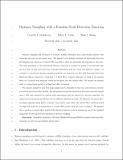Files in this item
Distance sampling with a random scale detection function
Item metadata
| dc.contributor.author | Oedekoven, C.S. | |
| dc.contributor.author | Laake, J.L. | |
| dc.contributor.author | Skaug, H.J. | |
| dc.date.accessioned | 2016-03-22T00:01:20Z | |
| dc.date.available | 2016-03-22T00:01:20Z | |
| dc.date.issued | 2015-12 | |
| dc.identifier | 180107219 | |
| dc.identifier | 24b1107a-38ce-4c44-b79c-8f58192d327d | |
| dc.identifier | 84947489330 | |
| dc.identifier | 000365258600008 | |
| dc.identifier.citation | Oedekoven , C S , Laake , J L & Skaug , H J 2015 , ' Distance sampling with a random scale detection function ' , Environmental and Ecological Statistics , vol. 22 , no. 4 , pp. 725-737 . https://doi.org/10.1007/s10651-015-0316-9 | en |
| dc.identifier.issn | 1352-8505 | |
| dc.identifier.other | ORCID: /0000-0002-5610-7814/work/61978845 | |
| dc.identifier.uri | https://hdl.handle.net/10023/8454 | |
| dc.description | Cornelia Oedekoven was supported by a studentship jointly funded by the University of St Andrews and EP-SRC, through the National Centre for Statistical Ecology (EP-SRC Grant EP/C522702/1). Hans Skaug thanks the Center for Stock Assessment Research for facilitating his visit to University of California, Santa Cruz. | en |
| dc.description.abstract | Distance sampling was developed to estimate wildlife abundance from observational surveys with uncertain detection in the search area. We present novel analysis methods for estimating detection probabilities that make use of random effects models to allow for unmodeled heterogeneity in detection. The scale parameter of the half-normal detection function is modeled by means of an intercept plus an error term varying with detections, normally distributed with zero mean and unknown variance. In contrast to conventional distance sampling methods, our approach can deal with long-tailed detection functions without truncation. Compared to a fixed effect covariate approach, we think of the random effect as a covariate with unknown values and integrate over the random effect. We expand the random scale to a mixed scale model by adding fixed effect covariates. We analyzed simulated data with large sample sizes to demonstrate that the code performs correctly for random and mixed effect models. We also generated replicate simulations with more practical sample sizes (∼100) and compared the random scale half-normal with the hazard rate detection function. As expected each estimation model was best for different simulation models. We illustrate the mixed effect modeling approach using harbor porpoise vessel survey data where the mixed effect model provided an improved model fit in comparison to a fixed effect model with the same covariates. We propose that a random or mixed effect model of the detection function scale be adopted as one of the standard approaches for fitting detection functions in distance sampling. | |
| dc.format.extent | 304573 | |
| dc.language.iso | eng | |
| dc.relation.ispartof | Environmental and Ecological Statistics | en |
| dc.subject | Abundance estimation | en |
| dc.subject | AD Model Builder | en |
| dc.subject | Half-normal | en |
| dc.subject | Harbor porpoise detections | en |
| dc.subject | Heterogeneity in detection probabilities | en |
| dc.subject | Mixed effects | en |
| dc.subject | HA Statistics | en |
| dc.subject | QH301 Biology | en |
| dc.subject | QL Zoology | en |
| dc.subject | DAS | en |
| dc.subject | BDC | en |
| dc.subject.lcc | HA | en |
| dc.subject.lcc | QH301 | en |
| dc.subject.lcc | QL | en |
| dc.title | Distance sampling with a random scale detection function | en |
| dc.type | Journal article | en |
| dc.contributor.sponsor | EPSRC | en |
| dc.contributor.institution | University of St Andrews. School of Mathematics and Statistics | en |
| dc.contributor.institution | University of St Andrews. Centre for Research into Ecological & Environmental Modelling | en |
| dc.identifier.doi | 10.1007/s10651-015-0316-9 | |
| dc.description.status | Peer reviewed | en |
| dc.date.embargoedUntil | 2016-03-22 | |
| dc.identifier.url | http://static-content.springer.com/esm/art%3A10.1007%2Fs10651-015-0316-9/MediaObjects/10651_2015_316_MOESM1_ESM.pdf | en |
| dc.identifier.grantnumber | EP/C522702/1 | en |
This item appears in the following Collection(s)
Items in the St Andrews Research Repository are protected by copyright, with all rights reserved, unless otherwise indicated.

